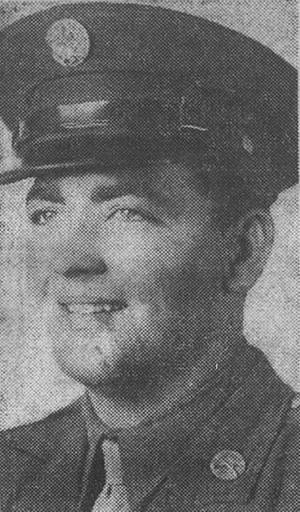
Webster Republican,
12 September 1945

Remember...
Chesley Casper Winkler
1921-1944
George Henry Winkler
1924-1944
"The world must know what happened, and never forget."

Webster Republican, 12 September 1945 |
Remember...Chesley Casper Winkler
|
While Randolph and Webster Counties are, as are many West Virginia locales, connected to coal mining, farming and lumbering were essential occupations in the area at the time of Chesley's and George's upbringing, as noted in their father's life work. In an interesting sidelight regarding the Winkler family, it seems that Chester's father Casper owned two farms in the central region of the state, one of whom was received by an older son, while the other became the property of Chester's sister, "Aunt Mary" Winkler. Aunt Mary's farm was almost certainly a tree farm. In 1963, Mary donated a "mammoth 101-year-old red spruce" to the presidential residence for display on the White House lawn. Standing at 78 feet, it was reported at the time to be one of the largest to ever grace that venue. ("Furnishing Tree for Capital Thrills Turkeybone Residents," Charleston Daily Mail, 7 December 1963.)
Chesley, most likely known as "Casper," and George Henry were part of a large farming family. Their siblings included Elsie May (b. 1907), Ida Jane (b. 1909), Chester Grant (b. 1911), Lee Alois (b. 1915), Hubert Dean (b. 1915), Mary (b. 1920), James O. (b. 1923), and Frank Allen (b. 1926). (Family information was extracted from census records, Find A Grave, and family trees registered on Ancestry.com.) Chesley's World War II draft card indicates his employment was "farming at home." George Henry's Army enlistment (U.S. World War II Army Enlistment Records, 1938-1946) notes that his education was that of "grammar school," and his civil occupation was of "farm hands, general farms." These educational and occupational descriptions were typical of men from large families in central West Virginia at the time. George enlisted in the U.S. Army at Clarksburg on May 13, 1943; although no enlistment record could be found for Chesley, it is likely he enlisted at the same place. Chesley was assigned to the 314th Infantry Regiment, 79th Infantry Division.
In its Division Chronicle, the 79th summarizes the operations in which Chesley would have participated:
After training in the United Kingdom from 17 April 1944, the 79th Infantry Division landed on Utah Beach, Normandy, 12-14 June and entered combat 19 June 1944, with an attack on the high ground west and northwest of Valognes and high ground south of Cherbourg. The Division took Fort du Roule after a heavy engagement and entered Cherbourg, 25 June. It held a defensive line at the Ollonde River until 2 July 1944 and then returned to the offensive, taking La Haye du Puits in house-to-house fighting, 8 July. ("79th Infantry Division—Cross of Lorraine," U.S. Army Divisions website, accessed 5 December 2023, https://www.armydivs.com/79th-infantry-division.)
Chesley was killed in action on July 5, 1944, which means he was killed in France somewhere between the Ollonde River engagement and La Haye du Puits.
George Henry Winkler became a member of the 119th Infantry Regiment, 30th Infantry Division. The Division's operations as they moved through the European Theater are chronicled by the 30th's association on its website:
On 12 February 1944, the 30th Infantry Division sailed for Europe, and settled on the south coast of England to participate in further training for the coming invasion. In June of 1944, after being fully trained and prepared, the 30th Infantry Division started crossing the English Channel to France on 6 June, D-Day, to replace some of the units of the 29th Infantry Division which suffered devastating losses in the initial attack. The remainder of the Division [crossed the channel] to Omaha Beach on 10 June and was almost immediately committed into combat against the experienced German Army.During combat, the 30th Infantry Division was known as the "Workhorse of the Western Front" and was named "Roosevelt's SS" by the German High Command because of the consistent vigor and terrific pressure the 30th Infantry Division brought to bear on Hitler's 'elite' 1st SS Division. The German 1st SS Division was the main force of resistance prior to the breakthrough at St. Lo, and again at Mortain, where the 30th stopped the 1st SS, thereby allowing Gen. George Patton's 3rd Army to race across France, shortening the war by many months. The German 1st SS Division was reorganized over the next few months, and again faced by the 30th in the "Battle of the Bulge" during the Ardennes-Alsace Offensive, near Malmedy, Belgium, in the winter of 1944-45. Again the 30th Infantry Division tore to shreds this 'elite' enemy division, which never returned to battle. ("Best Infantry Division in the ETO," 30th Infantry Division Association website, accessed 8 December 2023, https://30thinfantrydivision.weebly.com/wwii.html.)
Staff Sergeant George Henry Winkler lost his life on October 22, 1944, near Aachen in northwestern Germany, most likely in the Rhineland Operation, which began on September 15. His division was crucial to the winning of the war, participating in Normandy, Northern France, Rhineland, Ardennes-Alsace, and Central Europe campaigns. It was highly commended for its performance at the Battle of Mortain; the takeover of Aachen; and the liberation of Weferlingen, a sub-camp of Buchenwald. (United States Holocaust Memorial Museum, "The 30th Infantry Division during World War II," Holocaust Encyclopedia, accessed 8 December 2023, https://encyclopedia.ushmm.org/content/en/article/the-30th-infantry-division.)
Article prepared by Patricia Richards McClure
December 2023
 /
/ 
West Virginia Archives and History welcomes any additional information that can be provided about these veterans, including photographs, family names, letters and other relevant personal history.